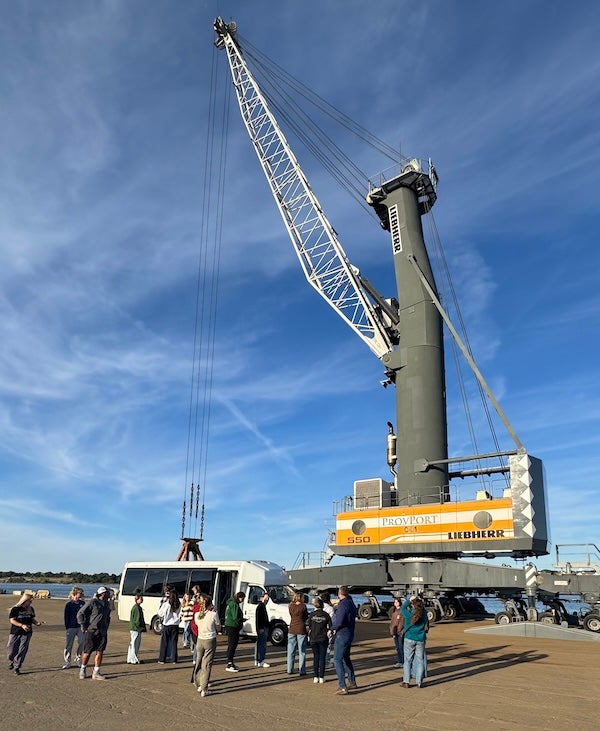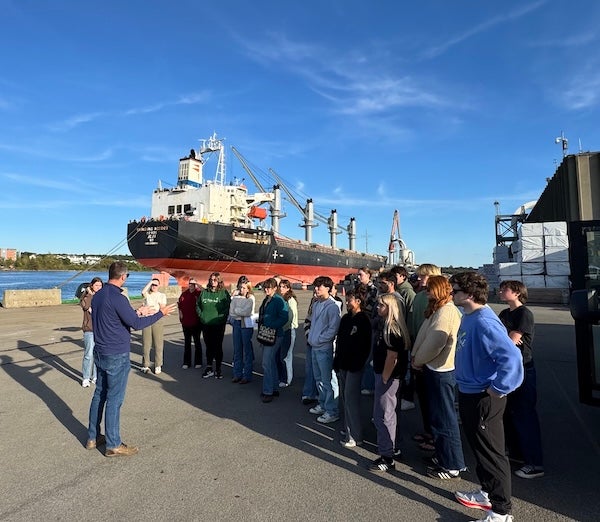Students in URI’s Shipping and Ports class recently visited the Port of Providence, connecting academic concepts with a firsthand look into the real-world operations of cargo operations, supply chains, and regional economics in a dynamic port environment.
One of only two deep water ports in New England, the Port of Providence is located at the convergence of Narragansett Bay and the Providence River and serves as a hub for international trade and domestic distribution.
“The fast-paced, real-world environment of the port makes maritime logistics come alive, linking classroom learning to Rhode Island’s and New England’s maritime economy,” says Professor Simona Trandafir, who holds a joint appointment in URI’s Departments of Marine Affairs and Environmental and Natural Resource Economics. “Seeing how cargo flows through a regional port helps students connect theory to practice and appreciate the critical role maritime infrastructure plays in both the local and global economy.”
While on site, students observed cement being unloaded from Turkey, learned about the growing offshore wind industry and its specialized cable logistics, and saw how high-value equipment such multi-million-dollar cranes support port efficiency. They also explored the roles of stevedores and longshoremen, and discovered how scrap vehicles are exported to markets in Africa.
“We learned that the port strives to operate in an environmentally responsible way, minimizing emissions and maintaining clean operations in an urban waterfront setting,” adds Trandafir.
Maria Crivac, a public relations major from Hudson, NH, with minors in marine affairs and psychology, described the visit as both eye-opening and engaging. “Exploring a port was something I had never done before,” she says. “It was exciting to experience something totally new.”
“We learned that speed is really important for port success,” Crivac adds, “Loading and unloading cargo fast keeps customers happy so they do not have to pay extra money for having the ship there longer.”

Student participants note that the incredible scale of operation is something that can only be appreciated when seen firsthand. “Coming from Cranston, I have driven past the Port hundreds of times but have never truly understood its scale and importance,” says Kalliana Marek, a double major in sustainable agriculture and marine affairs. “In our fast-paced, highly globalized world, there is so much movement and economic activity happening around us that we aren’t even aware of. This field trip gave a glimpse into the mountain-moving that is going on behind the scenes!”
A highlight for many students was the guided tour by John Gustus, Director of Operations at Waterson Terminal, the company that manages the Port of Providence, and a seasoned stevedore who brought the port’s operations to life for the students. “He was extremely knowledgeable and explained everything in a way we could understand,” Crivac notes. “His approachable style made it easy to stay engaged and learn.”
“In class, we’ve studied automation in container shipping,” Crivac adds. The Port of Providence is very different because much of the work is still done by hand. “For example, we learned that longshoremen manually wind extremely heavy cable by hand,” she says.
The Port of Providence served as an ideal learning environment, bridging classroom theory with practical application in Rhode Island’s maritime sector and highlighting the port’s critical role in both the local and global economy.

